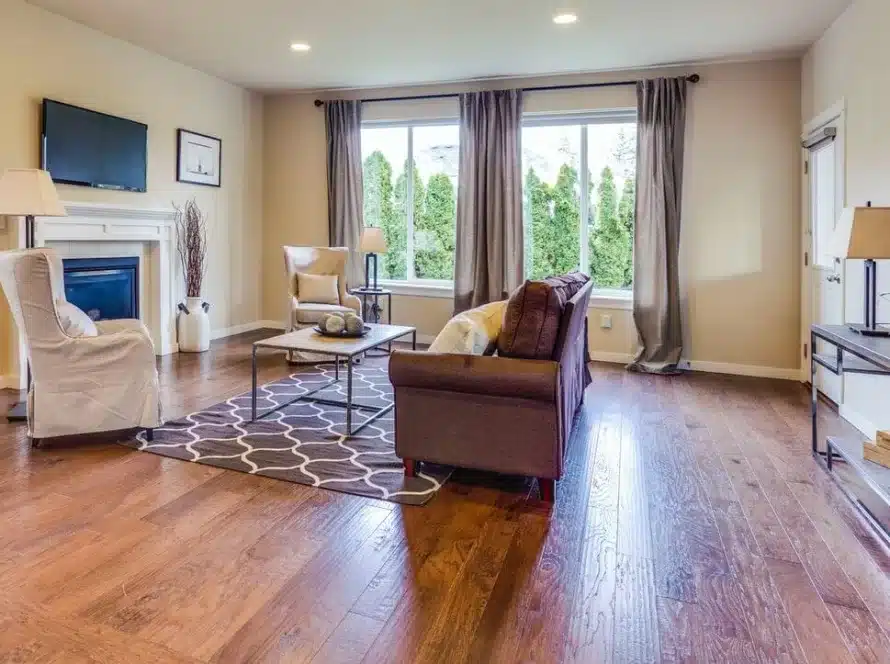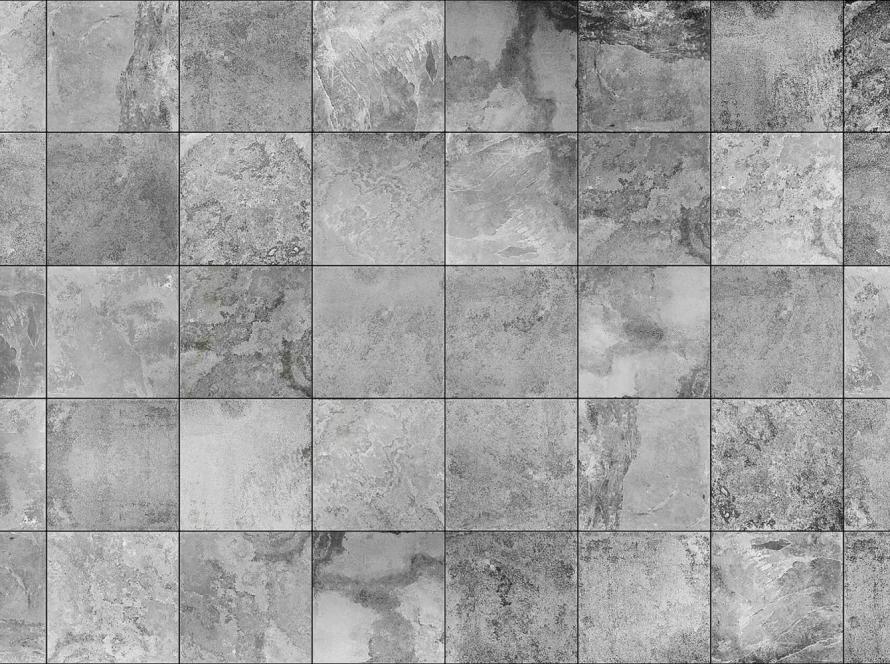Laminate flooring is a popular and practical choice for many homeowners, especially in kitchens. In fact, statistics show that nearly one in five new homes in the United States features laminate flooring. Its popularity is no surprise, given its durability, affordability, and ease of maintenance.
In this laminate floor installation guide, we’ll explore how you can effectively use laminate flooring in your kitchen. Whether you’re renovating or building from scratch, understanding the benefits and best practices for installation and maintenance can help you make the most of this versatile flooring option. Let’s get started.
What Is Laminate Flooring?

Laminate flooring is a type of synthetic flooring material that simulates the look of natural materials like wood, tile, or stone. It consists of several layers that undergo fusion via a lamination technique.
The top layer, known as the wear layer, is a transparent, protective coating that shields the flooring from scratches, stains, and fading. Beneath the wear layer is the decorative layer, which features a high-resolution image of the desired flooring design.
The core layer provides stability and resistance to moisture, while the bottom layer, called the backing layer, adds additional support and moisture protection. Laminate flooring typically comes in planks or tiles that are installed using a floating floor method, meaning they are not directly attached to the subfloor.
This versatile flooring option is known for its durability, affordability, and easy maintenance, making it a popular choice for kitchens, bathrooms, and other high-traffic areas in the home.
Advantages of Laminate Flooring in the Kitchen
Now, let’s take a closer look at the advantages of laminate flooring in the kitchen. These include its durability, ease of maintenance, affordability, and versatile design options.
Durability
Laminate flooring is engineered to withstand the demands of the kitchen environment, including spills, stains, and heavy foot traffic. Its tough surface layer provides protection against scratches and wear, ensuring long-lasting performance.
Easy maintenance
Keeping laminate flooring clean is simple and hassle-free. Regular sweeping or vacuuming, along with occasional mopping with a damp cloth, is usually all that’s needed to maintain its appearance.
Unlike some other flooring materials, laminate doesn’t require specialized cleaners or treatments, making upkeep a breeze.
Cost-effectiveness
Laminate flooring offers a budget-friendly option for homeowners without sacrificing quality or style. Compared to hardwood or tile, laminate is often more affordable both in terms of upfront costs and long-term maintenance expenses. This makes it an attractive choice for those looking to update their kitchen on a tight budget.
Versatility
With a wide range of styles, colors, and designs available, laminate flooring can complement any kitchen aesthetic. Whether you prefer the look of natural wood, stone, or tile, there’s a laminate option to suit your taste and décor preferences.
Incorporating Laminate Flooring in Your Kitchen
Incorporating laminate flooring into your kitchen is not just about functionality but also about enhancing the overall design and style of the space. Here are some tips to help you seamlessly integrate laminate flooring into your kitchen.
Choose the Right Floor Color and Finish
Selecting the right color and finish for your laminate flooring can set the tone for the entire kitchen design. Lighter shades like white or light oak can make a small kitchen feel more spacious.
Darker tones, meanwhile, like cherry or walnut, can add warmth and sophistication to larger kitchens. You should take time to consider the existing color scheme and decor of your kitchen when choosing the flooring to ensure a cohesive look.
Coordinate with Cabinets and Countertops
It’s a good idea to coordinate the color and style of your laminate flooring with your kitchen cabinets and countertops for a harmonious aesthetic. Opt for complementary or contrasting colors to create visual interest and balance in the space.
For example, if you have dark cabinets, lighter flooring can create a striking contrast, while matching the flooring to the cabinets can create a seamless, cohesive look.
Consider Plank Direction
The direction in which you lay the laminate planks can affect the visual perception of the space. Generally, laying the planks parallel to the longest wall can make the room appear larger, while laying them perpendicular to the cabinets can create a more cohesive flow. Experiment with different plank directions to find the best fit for your kitchen layout.
Incorporate Texture and Pattern
Laminate flooring comes in a variety of textures and patterns that can add depth and visual interest to your kitchen. Choose a textured finish for added grip and authenticity, or opt for a patterned design like herringbone or chevron for a modern twist.
Mixing different textures and patterns can create a dynamic and visually appealing look in your kitchen.
Pre-Installation Preparation

Before installing laminate flooring in your kitchen, it’s crucial to undertake some pre-installation preparations. Firstly, accurately measure the kitchen area where you plan to lay the flooring. This ensures you purchase the correct amount of laminate material and reduces the likelihood of wastage.
Next, choose the appropriate type and thickness of laminate flooring for your kitchen. Consider factors such as foot traffic, moisture levels, and your budget when making this decision. Thicker laminate flooring may offer more durability and sound insulation, while thinner options can be more cost-effective.
Once you’ve selected your laminate flooring, it’s time to prepare the subfloor. Make sure the subfloor is free from dirt, moisture, and level prior to installation. Remove any existing flooring material and debris, and repair any uneven or damaged areas to create a smooth surface for the laminate to adhere to.
Lastly, acclimate the laminate planks to the room’s temperature and humidity before installation. This helps prevent expansion or contraction of the flooring after installation, ensuring a more stable and long-lasting result. Allow the laminate planks to sit in the room for at least 48 hours before beginning the installation process.
Floor Installation Process
In the installation process of laminate flooring in your kitchen, following a DIY method can save you money and give you a sense of accomplishment. Firstly, gather all the necessary tools and materials for the installation. This typically includes:
- Laminate flooring planks
- Underlayment
- Spacers
- A saw (for cutting the planks)
- Tape measure
- A tapping block
Next, start by installing the underlayment, which helps to cushion the laminate flooring, reduce noise, and provide moisture protection. Unroll the underlayment over the entire kitchen floor space, ensuring a tight fit against the walls.
Then, begin laying the laminate planks row by row, starting from one corner of the room and working your way towards the opposite wall. Use spacers to maintain expansion gaps around the perimeter of the room, which allow the laminate flooring to expand and contract with changes in temperature and humidity.
As you progress, cut the planks as needed to fit around obstacles such as cabinets, appliances, or door frames. A saw or laminate cutter can be used for this purpose.
Finally, install transition strips at doorways and between different flooring materials to create a seamless transition and enhance the overall appearance of the flooring.
While DIY installation can be rewarding, it’s important to note that opting for professional installation has its benefits, including expertise, time-saving, and potentially better results.
Maintenance Tips
Maintaining laminate flooring in your kitchen is essential to preserve its beauty and functionality over time. By adhering to these straightforward maintenance guidelines, you can guarantee that your flooring remains clean, resilient, and maintains its optimal appearance over time.
Regular Sweeping or Vacuumin
Keeping your laminate flooring free of dirt and debris is crucial to prevent scratches and maintain its appearance. Use a soft-bristle broom or vacuum with a brush attachment to sweep or vacuum the floor regularly.
Prompt Spill Cleanup
Accidents happen, but cleaning up spills promptly can prevent them from seeping into the laminate and causing damage. Use a damp cloth or mop to wipe up spills as soon as they occur, ensuring no moisture is left behind.
Avoid Abrasive Cleaners
Harsh chemicals and abrasive cleaners can damage the protective layer of laminate flooring, leading to dullness and discoloration over time. Stick to gentle, non-abrasive cleaners specifically formulated for laminate floors to preserve their integrity.
Use Furniture Pads
It’s recommended that you place felt or rubber pads under furniture legs to prevent scratches and dents on the laminate surface. This simple step can significantly extend the lifespan of your flooring and keep it looking newer for longer.
Periodic Cleaning With Cleaner
While regular sweeping and spot cleaning are essential, periodically deep cleaning your laminate flooring with a manufacturer-recommended cleaner can remove stubborn dirt and grime. Be sure to follow the instructions on the cleaner’s label for best results, and avoid over-wetting the floor to prevent moisture damage.
How to Use Laminate Flooring in the Kitchen

Compare Quotes from Top-rated Flooring contractors in your area.
To sum up, incorporating laminate flooring into your kitchen can elevate both its style and functionality. If you’re considering floor installation or any other home improvement projects, Alpha Living offers a convenient solution.
Simply enter your zip code on our portal, and we’ll connect you with professional contractors who can assist with your needs. Let Alpha Living help you transform your space with quality flooring solutions and expert craftsmanship.





Facebook
Comments